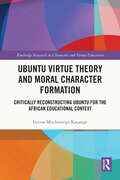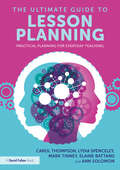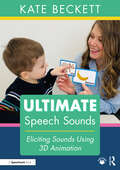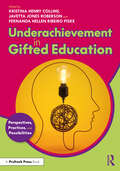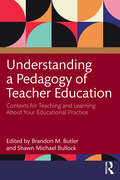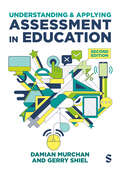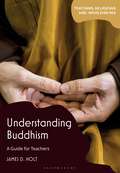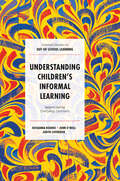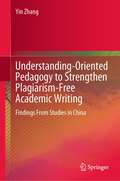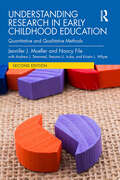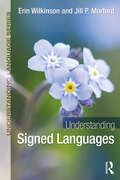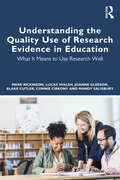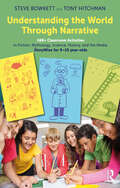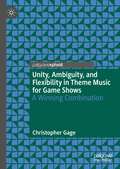- Table View
- List View
Ubuntu Virtue Theory and Moral Character Formation: Critically Reconstructing Ubuntu for the African Educational Context (Routledge Research in Character and Virtue Education)
by Grivas Muchineripi KayangeThis book investigates the ubuntu theory-based conception of virtue and moral character formation in the northern, western, and eastern regions of Africa, suggesting a critical reconstruction of ubuntu by conceptualising the four different forms of practices in moral character formation. Arguing for the critical reconstruction of ubuntu virtue theory as more nuanced than simply the standard ubuntu normative virtue theories (which give priority to the community as the sole locus for understanding virtues and character formation in Africa), the book builds a comprehensive model of virtue and moral character formation that draws insights from the reconstructed notion of ubuntu and other theories within and beyond the African thought. Chapters feature experience from across Africa including Malawi, Zambia, Zimbabwe, Uganda, Kenya, and South Africa, and centre on topics such as traditional cultural views and practices, political systems in various nations, neoliberalist thought, and primary, secondary and tertiary education systems in Africa and further afield. This is a valuable resource for scholars, academics, and postgraduate students, working in the fields of moral and values education, philosophy of education, and the theory of education more broadly. Those also interested in educational psychology may also find the volume of interest.
Ubuntu Virtue Theory and Moral Character Formation: Critically Reconstructing Ubuntu for the African Educational Context (Routledge Research in Character and Virtue Education)
by Grivas Muchineripi KayangeThis book investigates the ubuntu theory-based conception of virtue and moral character formation in the northern, western, and eastern regions of Africa, suggesting a critical reconstruction of ubuntu by conceptualising the four different forms of practices in moral character formation. Arguing for the critical reconstruction of ubuntu virtue theory as more nuanced than simply the standard ubuntu normative virtue theories (which give priority to the community as the sole locus for understanding virtues and character formation in Africa), the book builds a comprehensive model of virtue and moral character formation that draws insights from the reconstructed notion of ubuntu and other theories within and beyond the African thought. Chapters feature experience from across Africa including Malawi, Zambia, Zimbabwe, Uganda, Kenya, and South Africa, and centre on topics such as traditional cultural views and practices, political systems in various nations, neoliberalist thought, and primary, secondary and tertiary education systems in Africa and further afield. This is a valuable resource for scholars, academics, and postgraduate students, working in the fields of moral and values education, philosophy of education, and the theory of education more broadly. Those also interested in educational psychology may also find the volume of interest.
The Ultimate Guide to Lesson Planning: Practical Planning for Everyday Teaching
by Carol Thompson Lydia Spenceley Mark Tinney Elaine Battams Ann SolomonThis practical guide will help you to plan evidence-informed, innovative lessons that can be adapted to meet your individual student’s needs.Modelled on a typical lesson plan, the book covers all aspects of planning such as learning aims, starting a lesson, resources and activities, embedding skills, and assessment. Each chapter features a wide range of activities and strategies that can be used every day and easily adapted for different learners. The chapters also explore what to do when lessons don’t go to plan and how to use technology effectively to support learning. Throughout there are nuggets of useful theory to help you reflect not only on what works in the classroom but why.Written by an expert author team and linked to the early career framework, this is essential reading for all trainee and early career teachers across a wide range of educational settings.
The Ultimate Guide to Lesson Planning: Practical Planning for Everyday Teaching
by Carol Thompson Lydia Spenceley Mark Tinney Elaine Battams Ann SolomonThis practical guide will help you to plan evidence-informed, innovative lessons that can be adapted to meet your individual student’s needs.Modelled on a typical lesson plan, the book covers all aspects of planning such as learning aims, starting a lesson, resources and activities, embedding skills, and assessment. Each chapter features a wide range of activities and strategies that can be used every day and easily adapted for different learners. The chapters also explore what to do when lessons don’t go to plan and how to use technology effectively to support learning. Throughout there are nuggets of useful theory to help you reflect not only on what works in the classroom but why.Written by an expert author team and linked to the early career framework, this is essential reading for all trainee and early career teachers across a wide range of educational settings.
Ultimate Speech Sounds: Eliciting Sounds Using 3D Animation
by Kate BeckettEver faced challenges motivating clients to participate in speech therapy practice at home? Directing parents to helpful resources that reinforce acquired skills from therapy sessions can be a problem. This book provides easy-to-follow instructions, educational resources, and links to 3D animated clips for therapists to use with parents to ensure perfect technique every time. The book considers each of the 24 English consonants, 16 monophthongs, and 8 diphthongs in detail with regards to anatomy, physiological production, and therapy materials to be used in practice. It is accompanied by online 3D animated video material featuring DARA®, an avatar that sounds out each consonant or vowel, clearly showing how the shape of the mouth and positioning of the tongue forms each sound. Photocopiable and free downloadable material from Resourceible.com also makes ideal resources for parents to use at home. This book offers a toolkit to support technique explanation to parents and children rather than an education for therapists. It is a practical clinic resource to help speech therapists teach speech sound formation along with suggested elicitation techniques. This is an essential component for newly qualified and student SLTs as well as those more seasoned in the field.
Underachievement in Gifted Education: Perspectives, Practices, and Possibilities
This book provides an opportunity for researchers, professionals, and practitioners working directly with gifted individuals to engage with and examine the concept of underachievement of highly capable and talented individuals from different perspectives.Chapters written by experts in gifted education from diverse backgrounds explore underachievement in principle, illuminate underachievement as a response to written and unwritten policy and practice, showcase ranges of intellectual capability outside of traditional academic subjects, shift deficit views of not meeting rigid expectations to honoring interests and cultural values of the individual, and provide suggested and proven practices and services as solutions to bridge the gaps in achievement and performance for gifted and talented students.Expertly blending theory with practice, Underachievement in Gifted Education is a must read for all practitioners, educators of gifted individuals, and researchers seeking more opportunities to help students align how they choose to exhibit their talent and efforts with external and internal expectations, personal interests, and cultural values to reach their maximum potential.
Underachievement in Gifted Education: Perspectives, Practices, and Possibilities
by Kristina Henry Collins, Javetta Jones Roberson, and Fernanda Hellen Ribeiro PiskeThis book provides an opportunity for researchers, professionals, and practitioners working directly with gifted individuals to engage with and examine the concept of underachievement of highly capable and talented individuals from different perspectives.Chapters written by experts in gifted education from diverse backgrounds explore underachievement in principle, illuminate underachievement as a response to written and unwritten policy and practice, showcase ranges of intellectual capability outside of traditional academic subjects, shift deficit views of not meeting rigid expectations to honoring interests and cultural values of the individual, and provide suggested and proven practices and services as solutions to bridge the gaps in achievement and performance for gifted and talented students.Expertly blending theory with practice, Underachievement in Gifted Education is a must read for all practitioners, educators of gifted individuals, and researchers seeking more opportunities to help students align how they choose to exhibit their talent and efforts with external and internal expectations, personal interests, and cultural values to reach their maximum potential.
Understanding a Pedagogy of Teacher Education: Contexts for Teaching and Learning About Your Educational Practice
Providing readers with insights and examples of how teacher educators learn and teach a pedagogy of teacher education (PTE), Butler and Bullock organize a wholistic and practical resource for the next generation of teacher educators. Expanding on the highly referenced scholarship of John Loughran and Tom Russell, Understanding a Pedagogy of Teacher Education explores the learning of PTE through individual and collaborative endeavors, and large-scale institutional and cross-national initiatives. Contributors highlight their experiences teaching PTE in formal learning spaces, in international workshop settings, and on the program-wide scale in order to uncover how they came to understand PTE and enact it effectively. Each chapter connects broad strokes concepts of PTE to well-defined teacher education fields, such as social justice, literacy, early childhood education, and communities of practice. Blending well- established theory with contemporary examples, this book is a great tool for teacher education faculty, doctoral students, and those interested in improving their PTE or supporting others in their PTE learning.
Understanding a Pedagogy of Teacher Education: Contexts for Teaching and Learning About Your Educational Practice
by Brandon M. Butler Shawn Michael BullockProviding readers with insights and examples of how teacher educators learn and teach a pedagogy of teacher education (PTE), Butler and Bullock organize a wholistic and practical resource for the next generation of teacher educators. Expanding on the highly referenced scholarship of John Loughran and Tom Russell, Understanding a Pedagogy of Teacher Education explores the learning of PTE through individual and collaborative endeavors, and large-scale institutional and cross-national initiatives. Contributors highlight their experiences teaching PTE in formal learning spaces, in international workshop settings, and on the program-wide scale in order to uncover how they came to understand PTE and enact it effectively. Each chapter connects broad strokes concepts of PTE to well-defined teacher education fields, such as social justice, literacy, early childhood education, and communities of practice. Blending well- established theory with contemporary examples, this book is a great tool for teacher education faculty, doctoral students, and those interested in improving their PTE or supporting others in their PTE learning.
Understanding and Applying Assessment in Education
by Damian Murchan Gerry ShielAll teachers are responsible for assessing the children they teach, and the outcomes of any assessment are important for individual learners, schools and wider education systems. Designed as a pragmatic guide for new teachers and those training to teach, this book is your one-stop-shop for understanding assessment in schools. It covers formative and summative approaches used across primary and secondary education, supporting a balanced overview with policy examples drawn from the UK, Ireland and wider international contexts. This updated second edition reflects recent trends in assessment and includes: more balanced coverage across primary and secondary age phases with a broader range of examples across curriculum subject areas a new chapter on the potential of digital assessment for both formative and summative purposes the impact of the COVID-19 pandemic on assessment in general, and examinations in particular Damian Murchan is Associate Professor in the School of Education at Trinity College Dublin. Gerry Shiel is a Research Fellow at the Educational Research Centre, Dublin, Ireland.
Understanding and Applying Assessment in Education
by Damian Murchan Gerry ShielAll teachers are responsible for assessing the children they teach, and the outcomes of any assessment are important for individual learners, schools and wider education systems. Designed as a pragmatic guide for new teachers and those training to teach, this book is your one-stop-shop for understanding assessment in schools. It covers formative and summative approaches used across primary and secondary education, supporting a balanced overview with policy examples drawn from the UK, Ireland and wider international contexts. This updated second edition reflects recent trends in assessment and includes: more balanced coverage across primary and secondary age phases with a broader range of examples across curriculum subject areas a new chapter on the potential of digital assessment for both formative and summative purposes the impact of the COVID-19 pandemic on assessment in general, and examinations in particular Damian Murchan is Associate Professor in the School of Education at Trinity College Dublin. Gerry Shiel is a Research Fellow at the Educational Research Centre, Dublin, Ireland.
Understanding and Applying Assessment in Education
by Damian Murchan Gerry ShielAll teachers are responsible for assessing the children they teach, and the outcomes of any assessment are important for individual learners, schools and wider education systems. Designed as a pragmatic guide for new teachers and those training to teach, this book is your one-stop-shop for understanding assessment in schools. It covers formative and summative approaches used across primary and secondary education, supporting a balanced overview with policy examples drawn from the UK, Ireland and wider international contexts. This updated second edition reflects recent trends in assessment and includes: more balanced coverage across primary and secondary age phases with a broader range of examples across curriculum subject areas a new chapter on the potential of digital assessment for both formative and summative purposes the impact of the COVID-19 pandemic on assessment in general, and examinations in particular Damian Murchan is Associate Professor in the School of Education at Trinity College Dublin. Gerry Shiel is a Research Fellow at the Educational Research Centre, Dublin, Ireland.
Understanding Buddhism: A Guide for Teachers (Teaching Religions and Worldviews)
by James D. HoltBuddhism is often the religion that teachers have the least confidence in teaching despite being the sixth largest religion in the UK and being commonly regarded as one of the six major religions to be taught in schools throughout the country. This book explores the beliefs and practices of Buddhism as a lived religion in the UK. This book engages with Buddhist beliefs and practices and provides students and teachers with the confidence to address misconceptions and recognise the importance of beliefs in the lives of believers, in a way that will enable readers to go forward with confidence. Aspects of Buddhism explored include the concepts that form the central beliefs of Buddhism, and then the expression of these beliefs in worship, daily life, and the ethics of Buddhists in the modern day. Each chapter includes authentic voices of believers today and provides opportunities for the reader to consider the concepts and how they can be respected and taught and in the classroom.The book forms part of the Teaching Religions and Worldviews series of guides, each one designed to build teachers' confidence and expertise in teaching a different religion or worldview in the classroom..
Understanding Children's Informal Learning: Appreciating Everyday Learners (Emerald Studies in Out-of-School Learning)
by Roseanna Bourke John O’Neill Judith LoveridgeLearning and personal development are integral to being a person, and learning and teaching are integral to life as a social being. Understanding Children’s Informal Learning presents children’s informal learning out-of-school and explores how this knowledge can enhance teaching and learning practice in the classroom. The authors focus on the richness of children’s everyday learning, and in what ways children, teachers and schools can work to bring more of the everyday learning strengths that all children have into the interactional framework of the classroom. Offering practical applications for teachers and other education professionals, the chapters work to ensure children’s voices are heard and actively influence understandings of learning, so that out-of-school learning is legitimised as a critical constituent of in-school learning. Addressing the need to provide a strong ‘student voice’ component and strategies to support children’s learning both in-school and out-of-school, Understanding Children’s Informal Learning furthers comprehensive education research, policy, and practice.
Understanding Children's Informal Learning: Appreciating Everyday Learners (Emerald Studies in Out-of-School Learning)
by Roseanna Bourke John O’Neill Judith LoveridgeLearning and personal development are integral to being a person, and learning and teaching are integral to life as a social being. Understanding Children’s Informal Learning presents children’s informal learning out-of-school and explores how this knowledge can enhance teaching and learning practice in the classroom. The authors focus on the richness of children’s everyday learning, and in what ways children, teachers and schools can work to bring more of the everyday learning strengths that all children have into the interactional framework of the classroom. Offering practical applications for teachers and other education professionals, the chapters work to ensure children’s voices are heard and actively influence understandings of learning, so that out-of-school learning is legitimised as a critical constituent of in-school learning. Addressing the need to provide a strong ‘student voice’ component and strategies to support children’s learning both in-school and out-of-school, Understanding Children’s Informal Learning furthers comprehensive education research, policy, and practice.
Understanding-Oriented Pedagogy to Strengthen Plagiarism-Free Academic Writing: Findings From Studies in China
by Yin ZhangThis book discusses the plagiarism-free academic writing in higher education. It demonstrates how to orchestrate an understanding-oriented pedagogy (including the teaching of plagiarism and source use) in order to facilitate plagiarism-free academic writing among undergraduates by revealing studies in China. This book emphasizes that plagiarism is a mere symptom of educational problems and plagiarism urgently needs education-based solutions instead of punish solutions. It highlights that students' meaningful understandings of plagiarism and source use should be identified as the main learning objectives of plagiarism instruction, as well as features the adoption of plagiarism instruction in academic writing practices in subject courses. It also focuses on the potentials of Information and Communication Technology (ICT) in scaffolding learning and teaching under plagiarism pedagogy beyond merely detecting plagiarism. This book also contributes to the discussion about the validity of current plagiarism assessment scales by providing evidences to challenge them and proposing a new one. This book is of great benefits for readers to increase knowledge and promote positive attitudes toward plagiarism and plagiarism instruction. It adds to our knowledge of how plagiarism in higher education can be effectively prevented by adopting an understanding-oriented pedagogy. It also adds to our knowledge of how Chinese undergraduates and their instructors view plagiarism and cope with plagiarism in discipline-based courses, which provides robust evidence for the academic debate about whether culture has effects on students’ plagiarism in academic writing. Finally, it provides insights about the relationship among plagiarism, pedagogy, and technology.
Understanding Research in Early Childhood Education: Quantitative and Qualitative Methods
by Jennifer J. Mueller Nancy File Andrew J. Stremmel Iheoma U. Iruka Kristin L. WhyteThis second edition invites readers to be informed consumers of both quantitative and qualitative methods in early childhood research. It offers side-by-side coverage and comparison about the assumptions, questions, purposes, and methods for each, presenting unique perspectives for understanding young children and early care and education programs. The new edition includes updated examples and references as well as a new chapter on equity issues in research. By using this book, students will be able to read, evaluate, and use empirical literature more knowledgeably. These skills are becoming more important as early childhood educators are increasingly expected to use evidence-based research in practice and to participate in collecting and analyzing data to inform their teaching.
Understanding Research in Early Childhood Education: Quantitative and Qualitative Methods
by Jennifer J. Mueller Nancy File Andrew J. Stremmel Iheoma U. Iruka Kristin L. WhyteThis second edition invites readers to be informed consumers of both quantitative and qualitative methods in early childhood research. It offers side-by-side coverage and comparison about the assumptions, questions, purposes, and methods for each, presenting unique perspectives for understanding young children and early care and education programs. The new edition includes updated examples and references as well as a new chapter on equity issues in research. By using this book, students will be able to read, evaluate, and use empirical literature more knowledgeably. These skills are becoming more important as early childhood educators are increasingly expected to use evidence-based research in practice and to participate in collecting and analyzing data to inform their teaching.
Understanding Signed Languages (Understanding Language)
by Erin Wilkinson Jill P. MorfordUnderstanding Signed Languages provides a broad and accessible introduction to the science of language, with evidence drawn from signed languages around the world. Readers will learn about language through a unique set of signed language studies that will surprise them with the diversity of ways human languages achieve the same functional goals of communication. Designed for students with no prior knowledge of signed languages or linguistics, this book features: A comprehensive introduction to the sub-fields of linguistics, including sociolinguistics, linguistic structure, language change, language acquisition, and bilingualism; Examples from more than 50 of the world’s signed languages and a brief “Language in Community” snapshot in each chapter highlighting one signed language and the researchers who are documenting it; Opportunities to reflect on how language ideologies have shaped scientific inquiry and contributed to linguistic bias; Review and discussion questions, useful websites, and pointers to additional readings and resources at the end of each chapter. Understanding Signed Languages provides instructors with a primary or secondary text to enliven the discourse in introductory classes in linguistics, interpreting, deaf education, disability studies, cognitive science, human diversity, and communication sciences and disorders. Students will develop an appreciation for the language-specific and universal characteristics of signed languages and the global communities in which they emerge.
Understanding Signed Languages (Understanding Language)
by Erin Wilkinson Jill P. MorfordUnderstanding Signed Languages provides a broad and accessible introduction to the science of language, with evidence drawn from signed languages around the world. Readers will learn about language through a unique set of signed language studies that will surprise them with the diversity of ways human languages achieve the same functional goals of communication. Designed for students with no prior knowledge of signed languages or linguistics, this book features: A comprehensive introduction to the sub-fields of linguistics, including sociolinguistics, linguistic structure, language change, language acquisition, and bilingualism; Examples from more than 50 of the world’s signed languages and a brief “Language in Community” snapshot in each chapter highlighting one signed language and the researchers who are documenting it; Opportunities to reflect on how language ideologies have shaped scientific inquiry and contributed to linguistic bias; Review and discussion questions, useful websites, and pointers to additional readings and resources at the end of each chapter. Understanding Signed Languages provides instructors with a primary or secondary text to enliven the discourse in introductory classes in linguistics, interpreting, deaf education, disability studies, cognitive science, human diversity, and communication sciences and disorders. Students will develop an appreciation for the language-specific and universal characteristics of signed languages and the global communities in which they emerge.
Understanding the Quality Use of Research Evidence in Education: What It Means to Use Research Well
by Mark Rickinson Lucas Walsh Joanne Gleeson Blake Cutler Connie Cirkony Mandy SalisburyThis book focuses on the question of how to understand quality use of research evidence in education, or what it means to use research evidence well. Internationally there are widespread efforts to increase the use of research evidence within educational policy and practice. Such efforts raise important questions about how we understand not just the quality of evidence, but also the quality of its use. To date, there has been wide-ranging debate about the former, but very little dialogue about the latter. Based on a five-year study with schools and school systems in Australia, this book sheds new light on: why clarity about quality of use is critical to educational improvement; how quality use of research evidence can be framed in education; what using research well involves and looks like in practice; what quality research use means for individuals, organisations and systems; and what aspects of using research well still need to be better understood. This book will be an invaluable resource for professionals within and beyond education who want to better understand what using research evidence well means and involves and how it can be supported.
Understanding the Quality Use of Research Evidence in Education: What It Means to Use Research Well
by Mark Rickinson Lucas Walsh Joanne Gleeson Blake Cutler Connie Cirkony Mandy SalisburyThis book focuses on the question of how to understand quality use of research evidence in education, or what it means to use research evidence well. Internationally there are widespread efforts to increase the use of research evidence within educational policy and practice. Such efforts raise important questions about how we understand not just the quality of evidence, but also the quality of its use. To date, there has been wide-ranging debate about the former, but very little dialogue about the latter. Based on a five-year study with schools and school systems in Australia, this book sheds new light on: why clarity about quality of use is critical to educational improvement; how quality use of research evidence can be framed in education; what using research well involves and looks like in practice; what quality research use means for individuals, organisations and systems; and what aspects of using research well still need to be better understood. This book will be an invaluable resource for professionals within and beyond education who want to better understand what using research evidence well means and involves and how it can be supported.
Understanding the World Through Narrative: 160+ Classroom Activities in Fiction, Mythology, Science, History, and the Media: StoryWise for 9–15 year-olds
by Steve Bowkett Tony HitchmanWhile many educational books focus on creative and critical thinking skills, this ground-breaking work is the first to deal specifically with the ability to understand, question and evaluate information presented, broadly speaking, in story form. Story or narrative is central to our understanding of and interaction with the world around us. We only have to think of the ‘mini stories’ encapsulated in many advertisements; the way that topics in science – the story of human evolution for example, in history and other subjects present themselves; the power of myths and legends to act as guides to moral behaviour; and the pervasive way that gossip, rumour and superstition can spread – to recognise the benefits of heightening such awareness in young learners. Understanding the World Through Narrative explores the narrative structure of fiction, but uses this as a template to show how the story form appears in mythology and modern urban folklore, science, history, the media – including advertising; in our internal dialogues (stories we tell ourselves about ourselves and others), and how narrative structure can be used in curriculum planning to enhance children’s learning. The book contains over 160 thinking/discussing/researching activities for use in the classroom and as project work. Chapters can be used independently, although they are arranged with increasing degrees of sophistication and challenge. This fascinating work is an essential resource for any teacher of upper primary and lower secondary students, covering not only children’s evolving intellectual ability and promoting curiosity and critical engagement but also enhancing their mental and emotional wellbeing.
Understanding the World Through Narrative: 160+ Classroom Activities in Fiction, Mythology, Science, History, and the Media: StoryWise for 9–15 year-olds
by Steve Bowkett Tony HitchmanWhile many educational books focus on creative and critical thinking skills, this ground-breaking work is the first to deal specifically with the ability to understand, question and evaluate information presented, broadly speaking, in story form. Story or narrative is central to our understanding of and interaction with the world around us. We only have to think of the ‘mini stories’ encapsulated in many advertisements; the way that topics in science – the story of human evolution for example, in history and other subjects present themselves; the power of myths and legends to act as guides to moral behaviour; and the pervasive way that gossip, rumour and superstition can spread – to recognise the benefits of heightening such awareness in young learners. Understanding the World Through Narrative explores the narrative structure of fiction, but uses this as a template to show how the story form appears in mythology and modern urban folklore, science, history, the media – including advertising; in our internal dialogues (stories we tell ourselves about ourselves and others), and how narrative structure can be used in curriculum planning to enhance children’s learning. The book contains over 160 thinking/discussing/researching activities for use in the classroom and as project work. Chapters can be used independently, although they are arranged with increasing degrees of sophistication and challenge. This fascinating work is an essential resource for any teacher of upper primary and lower secondary students, covering not only children’s evolving intellectual ability and promoting curiosity and critical engagement but also enhancing their mental and emotional wellbeing.
Unity, Ambiguity, and Flexibility in Theme Music for Game Shows: A Winning Combination
by Christopher GageWith flashing lights, bright colors, and big money, game shows have been an integral part of American culture since the days of radio. While the music that accompanies game shows is charming and catchy, it presents two unique, opposing challenges: first, it must exhibit unity in its construction so that, at any point and for any length of time, it is a tuneful, recognizable signifier of the show to which it belongs; at the same time, it must also possess the ability to be started and stopped according to the needs of gameplay without seeming truncated. This book argues that game show music, in particular from 1960 to 1990, deploys a variety of shared techniques in order to manage these two goals, including theme-derived vamps; saturation of motivic material; and harmonic, rhythmic, and formal ambiguity. Together, these techniques make game show themes exciting, memorable, and perfectly suited to their role.
